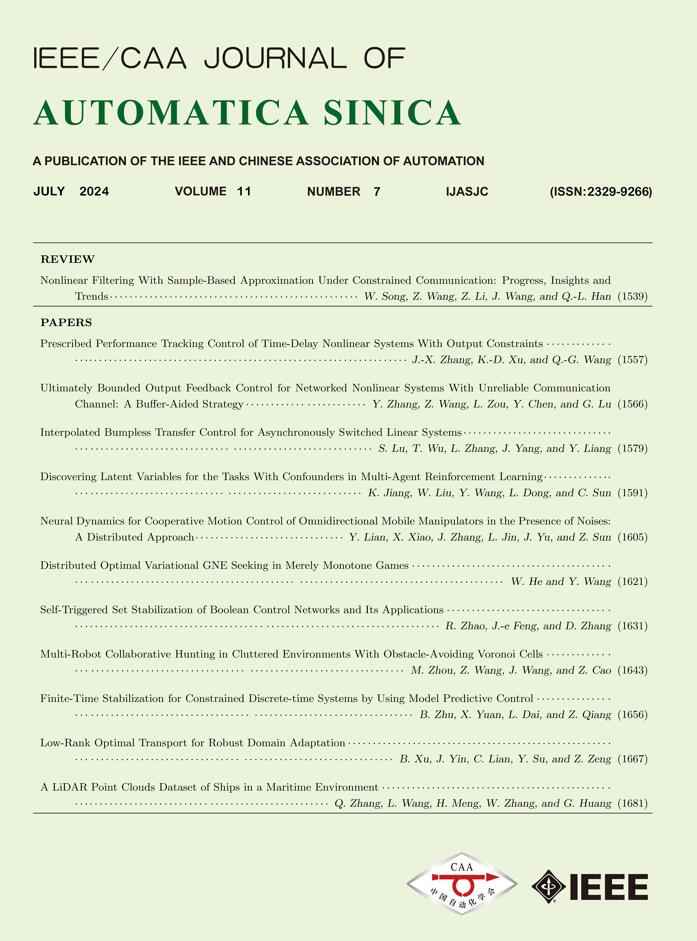 Volume 11
Issue 7
Volume 11
Issue 7
IEEE/CAA Journal of Automatica Sinica
| Citation: | Y. Guo, W. Xu, H. Wang, J. Lu, and S. Du, “Privacy-preserving average consensus algorithm under round-robin scheduling protocol,” IEEE/CAA J. Autom. Sinica, vol. 11, no. 7, pp. 1705–1707, Jul. 2024. doi: 10.1109/JAS.2023.123921 |

| [1] |
A. Jadbabaie, J. Lin, and A. S. Morse, “Coordination of groups of mobile autonomous agents using nearest neighbor rules,” IEEE Trans. Autom. Control, vol. 48, no. 6, pp. 988–1001, 2003. doi: 10.1109/TAC.2003.812781
|
| [2] |
R. Olfati-Saber, J. Fa, and R. Murray, “Consensus and cooperation in networked multi-agent systems,” Proc. IEEE, vol. 95, no. 1, pp. 215–233, 2007. doi: 10.1109/JPROC.2006.887293
|
| [3] |
Q. Xu, C. Yu, X. Yuan, Z. Fu, and H. Liu, “A privacy-preserving distributed subgradient algorithm for the economic dispatch problem in smart grid,” IEEE/CAA J. Autom. Sinica, vol. 10, no. 7, pp. 1625–1627, 2023. doi: 10.1109/JAS.2022.106028
|
| [4] |
W. Xu, W. He, D. W. C. Ho, and J. Kurths, “Fully distributed observer-based consensus protocol: Adaptive dynamic event-triggered schemes,” Automatica, vol. 139, p. 110188, 2022. doi: 10.1016/j.automatica.2022.110188
|
| [5] |
X. Fang, S. Misra, G. Xue, and D. Yang, “Smart grid — The new and improved power grid: A survey,” IEEE Communi. Surveys and Tutorials, vol. 14, no. 4, pp. 944–980, 2012. doi: 10.1109/SURV.2011.101911.00087
|
| [6] |
E. Nozari, P. Tallapragada, and J. Cortés, “Differentially private average consensus with optimal noise selection,” IFAC PapersOnLine, vol. 48, no. 22, pp. 203–208, 2015. doi: 10.1016/j.ifacol.2015.10.331
|
| [7] |
M. Ye, G. Hu, L. Xie, and S. Xu, “Differentially private distributed Nash equilibrium seeking for aggregative games,” IEEE Trans. Automa. Control, vol. 67, no. 5, pp. 2451–2458, 2022. doi: 10.1109/TAC.2021.3075183
|
| [8] |
A. Wang, X. Liao, and H. He, “Event-triggered differentially private average consensus for multi-agent network,” IEEE/CAA J. Autom. Sinica, vol. 6, no. 1, pp. 75–83, 2019. doi: 10.1109/JAS.2019.1911327
|
| [9] |
D. Fiore and G. Russo, “Resilient consensus for multi-agent systems subject to differentials privacy requirements,” Automatica, vol. 106, pp. 18–26, 2019. doi: 10.1016/j.automatica.2019.04.029
|
| [10] |
C. N. Hadjicostis and A. D. Dominguez-Garcia, “Privacy-preserving distributed averaging via homomorphically encrypted ratio consensus,” IEEE Trans. Autom. Control, vol. 65, no. 9, pp. 3887–3894, 2020. doi: 10.1109/TAC.2020.2968876
|
| [11] |
M. Ruan, H. Gao, and Y. Wang, “Secure and privacy-preserving consensus,” IEEE Trans. Autom. Control, vol. 64, no. 10, pp. 4035–4049, 2019. doi: 10.1109/TAC.2019.2890887
|
| [12] |
L. Zou, Z. Wang, Q.-L. Han, and D. Zhou, “Moving horizon estimation for networked time-delay systems under round-robin protocol,” IEEE Trans. Autom. Control, vol. 64, no. 12, pp. 5191–5198, 2019. doi: 10.1109/TAC.2019.2910167
|
| [13] |
Y. Wang, “Privacy-preserving average consensus via state decomposition,” IEEE Trans. Autom. Control, vol. 64, no. 11, pp. 4711–4716, 2019. doi: 10.1109/TAC.2019.2902731
|
| [14] |
H. Wang, W. Xu, and J. Lu, “Privacy-preserving push-sum average consensus algorithm over directed graph via state decomposition,” in Proc. 3rd Int. Conf. Industrial Artificial Intelligence, Shenyang, China, 2021, pp. 1–6.
|
| [15] |
Horn, A. Roger, and C. R. Johnson, Matrix Analysis. Cambridge, UK: Cambridge University Press, 2013.
|
| [16] |
X. Li, D. Ho, and J. Cao, “Event-triggered impulsive control for nonlinear delay systems,” Automatica, vol. 150, pp. 213–221, 2020.
|
| [17] |
X. Li, D. Ho, and J. Cao, “Finite-time stability and settling-time estimation of nonlinear impulsive systems,” Automatica, vol. 99, pp. 361–368, 2019. doi: 10.1016/j.automatica.2018.10.024
|
| [18] |
Q. Zhang and Y. Zhou, “Recent advances in non-gaussian stochastic systems control theory and its applications,” Int. J. Network Dynamics and Intelligence, vol. 1, no. 1, pp. 111–119, 2022.
|
| [19] |
Y. Su, H. Cai, and J. Huang, “The cooperative output regulation by the distributed observer approach,” Int. J. Network Dynamics and Intelligence, vol. 1, no. 1, pp. 20–35, 2022.
|
| [20] |
W. Xu, D. Ho, J. Zhong, and B. Chen, “Event/self-triggered control for leader-following consensus over unreliable network with DoS attacks,” IEEE Trans. Neural Networks and Learning Systems, vol. 30, no. 10, pp. 3137–3149, 2019. doi: 10.1109/TNNLS.2018.2890119
|